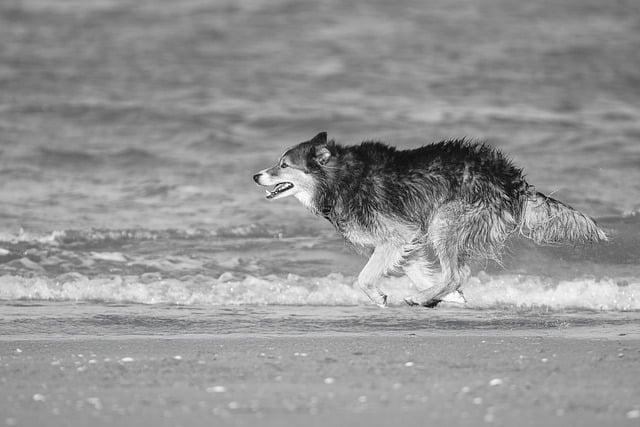Imagine coming home to find your dog trembling in the corner, tail tucked tightly between their legs. This is more than just a fleeting moment; it’s a sign of anxiety. Dogs may also exhibit excessive barking, destructive behavior, or even withdrawal from their favorite activities. Recognizing these signs is crucial for their well-being. By understanding your dog’s anxiety, you can take proactive steps to create a calmer environment, ensuring they feel safe and loved. Don’t wait—your furry friend is counting on you to help them find peace.
Contents
- Understanding Behavioral Changes as Indicators of Anxiety in Dogs
- Recognizing Physical Symptoms that Signal Distress in Your Canine Companion
- Exploring Environmental Triggers that Contribute to Dog Anxiety
- Implementing Effective Strategies to Alleviate Anxiety in Dogs
- Q&A
Understanding Behavioral Changes as Indicators of Anxiety in Dogs
Recognizing behavioral changes in dogs is crucial for identifying anxiety, as these shifts often serve as the first indicators of distress. Dogs are creatures of habit, and any deviation from their normal behavior can signal underlying issues. For instance, if your dog suddenly becomes more withdrawn or avoids interaction, it may be experiencing anxiety. This change can manifest in various ways, including:
- Increased hiding or retreating to a safe space: Dogs may seek solace in familiar spots when feeling anxious.
- Excessive barking or whining: Vocalizations can escalate as a response to stress or fear.
- Changes in appetite: A dog under stress might eat less or show disinterest in food.
Another common sign of anxiety is the alteration in a dog’s energy levels. Some dogs may become hyperactive, exhibiting restlessness or pacing, while others may display lethargy and a lack of enthusiasm for activities they once enjoyed. This inconsistency can be alarming for pet owners, as it disrupts the dog’s usual demeanor. Pay attention to these shifts, as they can indicate a deeper emotional struggle. Look for signs such as:
- Increased destructiveness: Chewing or digging can be a way for anxious dogs to cope with their feelings.
- Compulsive behaviors: Repetitive actions, like spinning or tail chasing, may arise as a response to anxiety.
- Difficulty settling down: An anxious dog may find it hard to relax, often pacing or shifting positions frequently.
Physical symptoms can also accompany behavioral changes, providing further insight into your dog’s emotional state. Anxiety can manifest in various physical ways, which may not be immediately obvious. For example, excessive panting, drooling, or trembling can indicate that your dog is feeling overwhelmed. Additionally, you might notice:
- Changes in body posture: A dog may exhibit a lowered head, tucked tail, or flattened ears when anxious.
- Gastrointestinal issues: Stress can lead to diarrhea or vomiting in some dogs.
- Increased sensitivity to touch: An anxious dog may flinch or pull away when petted.
Understanding these behavioral changes is essential for addressing anxiety in dogs effectively. By being observant and responsive to your dog’s needs, you can create a supportive environment that helps alleviate their stress. Early intervention can lead to better outcomes, allowing your furry friend to regain their confidence and happiness. Recognizing the signs of anxiety is the first step toward providing the care and comfort your dog deserves.
Recognizing Physical Symptoms that Signal Distress in Your Canine Companion
Understanding your dog’s physical symptoms is crucial in identifying their emotional state. When a canine companion is experiencing anxiety, their body often communicates distress in various ways. Look for signs such as **trembling**, **shaking**, or **excessive panting**, which can indicate that your dog is feeling overwhelmed. These physical manifestations can be subtle or pronounced, but they are essential indicators of your pet’s mental well-being.
Another common symptom to watch for is **excessive drooling** or **licking**. If your dog suddenly starts drooling more than usual or obsessively licking their lips or paws, it may be a sign of anxiety. Additionally, **changes in posture** can reveal a lot about your dog’s emotional state. A dog that is anxious may exhibit a lowered body posture, tucked tail, or flattened ears, all of which signal discomfort and unease.
Pay attention to your dog’s **appetite** and **sleep patterns** as well. A sudden loss of interest in food or a noticeable increase in restlessness can indicate that something is troubling your furry friend. Dogs that are anxious may also pace back and forth or have difficulty settling down, which can be distressing for both the pet and the owner. Recognizing these changes can help you address the underlying issues more effectively.
Lastly, consider your dog’s **vocalizations**. Increased barking, whining, or howling can be a cry for help, signaling that your dog is feeling anxious or distressed. These vocal signs, combined with the physical symptoms mentioned, create a clearer picture of your dog’s emotional health. By being vigilant and responsive to these signals, you can take proactive steps to alleviate your dog’s anxiety and improve their overall quality of life.
Exploring Environmental Triggers that Contribute to Dog Anxiety
Understanding the environmental factors that can lead to anxiety in dogs is crucial for pet owners who want to create a calm and secure atmosphere for their furry companions. Various stimuli in a dog’s surroundings can trigger stress responses, making it essential to identify and mitigate these triggers. Common environmental factors include loud noises, unfamiliar people or animals, and changes in routine.
**Loud noises** such as thunderstorms, fireworks, or even construction sounds can be particularly distressing for dogs. Many pets have a heightened sensitivity to sound, which can lead to panic attacks or destructive behavior. It’s important for owners to observe their dogs during these events and consider providing a safe space, such as a cozy crate or a quiet room, where they can retreat when feeling overwhelmed.
Another significant contributor to canine anxiety is the presence of **unfamiliar people or animals**. Dogs are naturally territorial and may feel threatened by strangers entering their space. This can lead to anxiety-driven behaviors such as barking, growling, or hiding. Socialization is key; gradually introducing your dog to new experiences and environments can help them build confidence and reduce anxiety in the presence of others.
Lastly, **changes in routine** can also trigger anxiety in dogs. Pets thrive on consistency, and disruptions such as moving to a new home, changes in family dynamics, or alterations in daily schedules can create uncertainty. Maintaining a predictable routine and providing plenty of reassurance can help ease your dog’s anxiety during transitional periods. By being mindful of these environmental triggers, pet owners can take proactive steps to foster a more relaxed and secure environment for their beloved dogs.
Implementing Effective Strategies to Alleviate Anxiety in Dogs
Understanding the signs of anxiety in dogs is crucial for pet owners who want to ensure their furry companions lead happy and healthy lives. Dogs, much like humans, can experience a range of emotions, and anxiety can manifest in various ways. Recognizing these signs early can help in implementing effective strategies to alleviate their distress.
Common indicators of anxiety in dogs include:
- Excessive Barking: If your dog barks more than usual, especially during specific triggers like thunderstorms or when left alone, it may be a sign of anxiety.
- Destructive Behavior: Chewing furniture, digging, or scratching at doors can indicate that your dog is feeling stressed and is trying to cope with their anxiety.
- Changes in Appetite: A sudden increase or decrease in food intake can signal emotional distress. Dogs may refuse to eat or overeat when they are anxious.
- Avoidance or Hiding: If your dog seeks out secluded spots or avoids interaction with family members, it may be trying to escape from its anxiety triggers.
Physical signs are also important to observe. Dogs may exhibit behaviors such as:
- Panting or Shaking: Rapid breathing or trembling can indicate that your dog is feeling overwhelmed.
- Excessive Licking or Grooming: This can be a self-soothing behavior, but it may also lead to skin issues if it becomes compulsive.
- Restlessness: An anxious dog may have difficulty settling down, pacing back and forth or constantly changing positions.
Being attentive to these signs allows you to take proactive measures. Implementing effective strategies such as creating a safe space, using calming aids, or consulting a professional trainer can significantly improve your dog’s emotional well-being. By addressing anxiety early on, you can foster a more relaxed environment for your pet, enhancing their quality of life and strengthening your bond with them.
Q&A
-
What are the physical signs of anxiety in dogs?
Dogs may exhibit various physical signs of anxiety, including:
- Excessive panting
- Trembling or shaking
- Restlessness or pacing
- Hiding or seeking refuge
-
How can I tell if my dog is anxious during specific situations?
Situational anxiety can manifest through behaviors such as:
- Barking or whining excessively
- Destructive behavior, like chewing furniture
- Refusing to eat or drink
- Trying to escape or flee
-
Are there behavioral signs that indicate anxiety in dogs?
Yes, behavioral signs of anxiety can include:
- Avoidance of eye contact
- Excessive licking or grooming
- Submissive posture, such as cowering
- Increased aggression or irritability
-
What should I do if I notice signs of anxiety in my dog?
If you observe signs of anxiety, consider taking the following steps:
- Consult with a veterinarian for a proper assessment
- Implement training techniques to reduce anxiety
- Provide a safe and comforting environment
- Consider professional help from a dog behaviorist
recognizing the signs of anxiety in dogs is crucial for their well-being. By being vigilant and proactive, you can provide the support they need. Don’t wait—take action today to ensure your furry friend lives a happier, healthier life.

大家好,我是彼得潘,專業的手法身體治療師。我喜歡探索和研究各種主題,並透過與人工智慧的合作分享專業、實用、有趣的文章。我們定期進行人工審核,以確保內容的準確性。如果您發現文章中有任何不準確的地方,請隨時與我們聯繫,我們會及時糾正。您可以透過 [email protected] 與我們聯繫。



